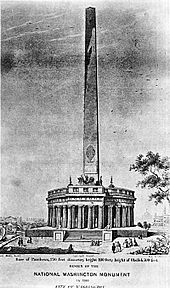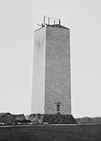The Washington Monument
The Washington Monument, one of the most recognizable buildings in the American capital, dates to 1888 and was, for a time, the tallest structure in the world. 
The idea of building a monument to Washington, the most revered of all the Founding Fathers, took hold after the end of the Revolutionary War. Washington himself resisted such an idea, and the matter was laid to rest until Washington himself was. After his death, in 1799, Congress, led by future Chief Justice of the United States John Marshall, agreed to build such a memorial. In the Election of 1800, the Democratic-Republican Party, led by President Thomas Jefferson, swept into power; leaders of that party considered Washington to be a member of the opposition political party, the Federalists, in all but name and detested the idea of building a monument to him or anyone else. Opposition to a Washington memorial waned in the next few decades; and in 1833, a large handful of people formed the Washington National Monument Society. They raised the equivalent of $1 million in dontaions and announced a competition for the memorial design. 
Well-known architect Robert Mills won the competition with a design for an obelisk, at the bottom of which would be a circular Greek-columned building adorned with a statue of Washington, standing in a chariot and holding the reins of six horses. Initial estimates for completion exceeded the amount of money raised, and further donations dried up. The Monument Society decided in 1848 to build only the obelisk. The intended site for the monument, which was even included in the 1791 plan for the city (put together by Pierre Charles L'Enfant and reproduced by his African-American counterpart Benjamin Banneker, proved to be on ground too weak to support such a tall and heavy monument, so the builders chose another spot, the current location. Construction began in 1848, with the cornerstone being laid on July 4. About 20,000 people attended the ceremony, including then-President James K. Polk, three future Presidents (James Buchanan; Abraham Lincoln, and Andrew Johnson); former First Lady Dolley Madison, and Elizabeth Hamilton, widow of Alexander Hamilton. 
Not for the last time, construction was halted in 1854 because of lack of funds; at the time, the structure was 152 feet tall. Disagreements within the group of people building the monument, coupled with the advent of the Civil War and a brief yet effective obstruction campaign by the Known Nothing Party, served to postpone construction until 1879. Once the building began again, it continued in earnest, with all but the finishing touches done in 1884. The well-known pyramid-shaped capstone was set on December 6 of that year. The finished product contained more than 36,000 blocks and weighed more than 90,000 tons. More than 800 people attended a dedication ceremony on Feb. 21, 1885, that officially introduced the 555-foot-tall monument to the world. On that day, President Chester A. Arthur gave a speech, as did The outside was complete, but the inside was not. Work on the interior (including an 897-step stairway) continued, and the official opening was Oct. 9, 1888. The Washington Monument was the tallest building in the world until the construction of the Eiffel Tower. |
Social Studies for Kids |



 Ohio Senator John Sherman; Virginia Gov. John Daniel; and Dr. James C. Welling, on behalf of the Washington National Monument Society's William Wilson Corcoran, who was too ill to attend.
Ohio Senator John Sherman; Virginia Gov. John Daniel; and Dr. James C. Welling, on behalf of the Washington National Monument Society's William Wilson Corcoran, who was too ill to attend.